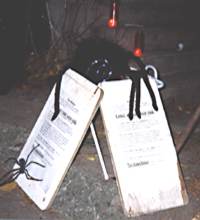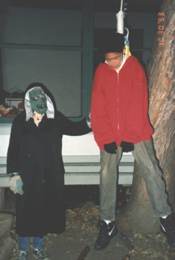the Haunted House
presented by Bridges Alumni and Friends
DarkApple.com
 |

|
 |
|
In this section we share some hard-won lessons for would-be
Haunted House creators. Our first productions were rougher and
more wild; our procedures and rules evolved as we learned and
as the kids grew. The public Notice and The Rules (text below) were posted
at the entrance to the Haunted House.
You are welcome to copy and use our materials!* |
The Rules
In order to have a truly scary (fun!) and safe Haunted
House, we have a few basic rules, for players and audience:
Enter at your own risk.
Be careful in the dark. You WILL be freaked!
No kids under age six admitted, even if accompanied
by parent, and no one with a heart condition. Believe it -- this
is a real Haunted House! We want to scare you witless, not cause
permanent damage.
No horseplay. Because a lot of work goes into
sets and costumes, and because there is electricity and breakable,
expensive equipment, we cannot allow complete craziness to break
out in the Haunted House. If you need to freak out, go to the
park -- thank you!
Two times through is your limit. We've found
that familiarity breeds rowdiness.
No food or drink in the Haunted House.
Don't touch the monsters and they won't touch
you.
Top of page
Notice!!!
This Haunted House is Theater, not reality.
It is not Politically Correct. There is lots of pretending
here, although none of it to moral rigor.
Do not attempt these activities in real life -- doing
so will imperil at least your body, and likely also your mind,
your soul and your social standing.
If you are offended by the bizarre, if you dislike
body parts unconnected to bodies, if Youthful Flights of Fantasy
make you nervous, we advise you avoid this place.
However, if you like that stuff....
Come On In !
Top of page
Lessons Learned

 Unintended meanings
Unintended meanings
Sometimes the simplest things are the most powerful. The Hanging
was one scene that usually got the biggest reaction because the
Victim was a real, twitching person, not just a mannequin. The
kids wouldn't have it any other way. With a carefully rigged construction
harness it was also one of our safest and least expensive effects.
Inadvertently however, it also deeply affected our approach to
selecting and presenting scenes.
Typically, the Hangman and the Victim would trade places every
fifteen minutes or so -- being hanged is physically demanding,
but is by far the most fun, so everybody has to have a turn. During
one evening's performance, the actors had grown tired of wearing
their hot masks and removed them. Some audience members noticed
that the Victim was a child of color and complained. The roles
had been reversed a few minutes earlier, but the people who were
offentded hadn't seen that version of the performance. Our group
of kids has always been ethinically diverse and it hadn't occured
to us that this kind of depiction could have real, unintended
power.
The outcome was a basic principle that shaped all future productions.
The kids agreed that the community's perception of a scene was
important, but we weren't about to restrict who could play which
role. After all, Halloween is intrinically about pain and death
of all kinds (and the fear of death), which is a deeply human
experience that cuts across all racial and cultural lines. So,
after a lengthy group discussion, we resolved that from now on
our performances would not depict violence of the human-to-human
variety. And because the children had participated actively in the decision-making, they became the guardians and enforcers of the new policy.
Practically, that meant making some thematic adjustments as
well as some sacrifices, in that sometimes uncomfortable masks
had to be worn, by someone at least, at all times. So for example,
either the victim in The Cult scene couldn't be a Virgin, but instead
had to be a ghoul, or else The Cult must all be ghouls. . And the Evil Tooth Fairy with a giant bloody
pliers looming over a sleeping child must be masked
or otherwise identifiable as a non-human. On the other hand, accidental death or mayhem -- e.g. the sweet Christmas tableau with a child
decorating the tree who falls off the stepladder only to be hanged
by a string of lights -- was just fine.
 It takes a community to pretend
to a child
It takes a community to pretend
to a child
We quickly discovered that we were able to present a Haunted
House which was genuinely frightening, even to many adults. We
also discovered that parents and children aren't always aware
that very young children cannot seperate this kind of fantasy
from reality. So we instituted the rule that children six and
under were not to enter.
However, not all parents wished to accept our recommendation
-- despite the advice of our Greeters at the entrance -- and from
time to time we would have young children in the audience who
would become very afraid and upset. When this occured, our actors
and PeaceKeepers were coached to remove their masks, step out
of character and interact with the child in a gentle manner as
'normal' people, telling the child that "this is all just
pretend". The parents were then coached in turn to respect
their child's fears and all were guided back through the Haunted
House the way they entered.
Top of page
PeaceKeepers

|
Anyone who has produced a Haunted House knows that crowd control
must be taken seriously. It is easy for rambunctious children
and teens to mistake the energy of the production as license for
their own wild behavior. We also typically had far more kids
interested in participating during performances than we had roles
to play or physical space, a situation which wasn't inclusive,
and could easily become disruptive. The PeaceKeepers were an innovative
solution to both issues.
PeaceKeepers were a team of teens which Oma/Vic trained beforehand
to manage and guide small audience groups. They carried Lightsaber-like
flashlights, and were often costumed. As they led their group
through the dark, they provided a more structured and safer experience
for the audience. They were coached to be alert for trouble or
danger, and to be respectful but assertive.
Our actors quickly discovered and exploited another benefit
however: the PeaceKeepers could help them control their timing.
The sophistication of the scenes immediately increased beyond
simple screaming or other repetitive (and quckly boring) 'scary'
activities. With the PeaceKeepers pacing the groups, the actors
had the ability to hone short skits -- with an opening, a set-up
and a scary pay-off -- and then have time to get back into position before
the next group arrived. So the PeaceKeepers raised the level of
theater we could achieve, and they became part of the performance
after all. |
Top of page
Invitation
(typically sent to parents and kids in late summer)
We'd like to extend a special invitation to you and your family
to join us at the Sixth Annual Downing Street Haunted House!
This year some 50 or 60 kids, aged 9 to 18 are working weekends
and evenings, to plan and construct two nights of fun and frights!
All kids are invited to participate. Parents, send food!
It'll be weirder and better than ever, so if you've
experienced it before, there's even more scares this time around!
Check it out!
Workdays: Thursday & Friday, October 26th and 27th,
10am to 4pm and later. There's no school these days-it's potluck-ish.
Bring food!
Haunted House Performance Days:
Friday & Saturday, October 27th and 28th, 7:00
to 9:00pm
For all participants: Come early to get into your costume.
There will be a spaghetti dinner right after the Haunted
House!
Cleanup Party: Sunday October 29th, 11am to 5pm.
Putting on a Haunted House is a lot of work and we make clean-up
a party. Please come on Sunday to help "strike the show".
Warm homemade cinnamon rolls will be served.
* The animated skull GIF is from the website of Mesa View Junior
High School in Farmington, New Mexico
Top of page



 Unintended meanings
Unintended meanings
 Comments? lou@designcoalition.org
Comments? lou@designcoalition.org